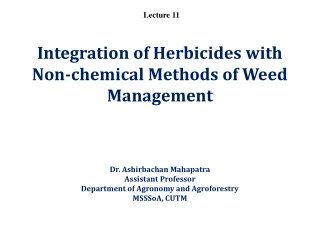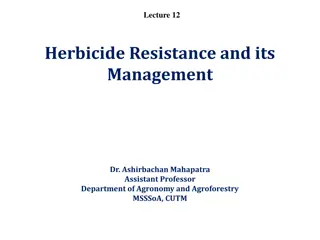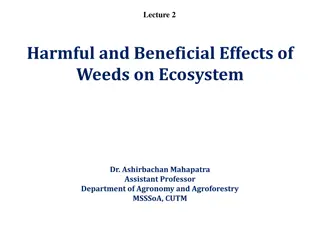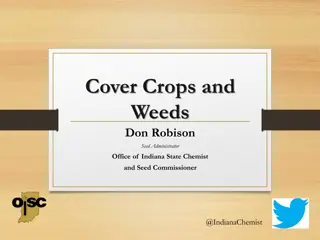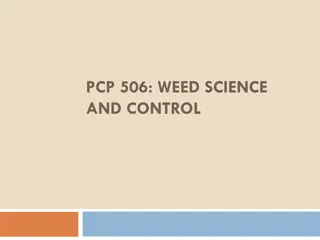Understanding the Importance of Weed Control Strategies in Agriculture
Weeds compete with crop plants for resources and harbor pests, leading to significant economic losses for farmers. Traditional weed control methods like manual weeding are becoming costly, prompting the need for alternative strategies such as allelopathy. Allelopathy involves using natural plant compounds to inhibit weed growth, offering an effective, economical, and environmentally-friendly approach to weed management.
Download Presentation

Please find below an Image/Link to download the presentation.
The content on the website is provided AS IS for your information and personal use only. It may not be sold, licensed, or shared on other websites without obtaining consent from the author. Download presentation by click this link. If you encounter any issues during the download, it is possible that the publisher has removed the file from their server.
E N D
Presentation Transcript
To study different breeding strategies for weeds control
Weeds compete with crop plants for water, nutrients, sunlight, and space and also harbor insect and disease pests. With continuously increasing labor cost, manual weeding has become an expensive field operation for any crop and farmers are increasingly opting for cultivars tolerant to herbicides. The losses due to weeds are estimated to be 11 billion USD per year, which varied from 13.8% in transplanted rice to 76% in soybean. Among all biotic stresses, weeds cause the highest potential loss (34%) with insect (18%) and pathogens (16%) being less important. Initially, hand weeding dominated most weeding practices, but it was gradually replaced (in rural India wage rate for men increased up to 400% from INR 67 in 2004 to INR 276 in 2018. Mechanical weed control practices are now viewed to be unsatisfactory due to the high-energy requirements and other associated costs, plus the perceived facilitation of soil erosion and compaction
Weed interference is one of the most important limiting factors which decrease crop yields and consequently global food production. At the earlier times, since no synthetic chemicals were known, weed control by some methods such as hand weeding, crop rotation, polyculture. Therefore, there is an urgent need to develop alternative weed control methods for use in agro-eco systems.
Allelopathy The term allelopathy was first introduced by Hans Molisch in 1937 Allelopathy is the releasing of allelopathic compounds by one plant species that inhibit the growth and development of neighbouring plants of another species. Refers to chemical interactions among plants, including those mediated by microorganisms. allelopathy - the effects of one plant on another plant through the release of a chemical compounds into the environment. Allelopathy can play a beneficial role in various cropping systems such as mixed cropping, multiple cropping, cover cropping, crop rotations, and minimum and no tillage systems. The exploitation of allelopathy in agricultural practices as a tool for weed control has shown weed reduction, pathogen prevention and soil enrichment. Allelopathy is considered as an effective, economical and environment friendly weed management approach. The release of allelopathic compounds from leaves, flowers, seeds, stems and roots of living and decomposing plant materials can influence weed density and growth.
Black Walnut (Juglans nigra) Ailanthus Rice (Oryza sativa), Pea (Pisum sativum), Sorghum
Allelopathy and allomones both are similar in their action (T/F).
Use of crop cultivars with allelopathic properties Crop cultivars differ in their allelopathic ability. and thus superior cultivars can be selected for weed management programs. Many weed species are most susceptible to allelochemicals in the seed and seedling stages.
Ways by which allelopathy can be used to control weeds in cropping systems In general, the use of allelopathy as a tool to control weeds can be achieved in different ways: 1. Use of crop cultivars with allelopathic properties. 2. Application of residues and straw of allelopathic crops as mulches or incorporated into the soil. 3. Use of an allelopathic crop in a rotational sequence. 4. Application of allelochemicals or modified allelochemicals as herbicides 5. Modification of crops to enhance their allelopathic effects.
The combined effects of allelopathy and competition determine the weed suppressive potential of a given cultivar. Both allelopathy and competitive ability are complex, quantitatively inherited traits that are heavily influenced by environmental factors. Weed suppressive rice cultivars are now commercially available in the U.S. and China. Weeds are the major constraint to upland rice (Oryza sativa) production, and hand weeding is the major source of control. Yield losses due to weeds, particularly barnyardgrass (Echinochloa crus-galli), are increasing as Asian farmers switch from labor-intensive hand transplanting to direct seeded systems for rice . Developing grain cultivars with superior competitive ability against weeds will complement cultural methods for weed control in maintaining acceptable yields and suppressing weed populations. These crop plants likely will not eradicate weeds as thoroughly as synthetic herbicides, but rather allow for coexistence of competing weed plants with much reduced vigor.
Both allelopathy and competitive ability are complex, qualititavely inherited traits that are heavily influenced by environmental factors (T/F)
Weed suppressive cultivars could be employed as a supplement to herbicides because herbicide performance is often improved when competitive cultivars are used. Less frequent or reduced rates of herbicide application in combination with competitive cultivars has the potential to be an economically viable alternative to conventional weed management. Variation in weed suppressive ability has been observed between crop species. The ability to sustain higher yields relative to other cultivars in the presence of weeds is sometimes referred to as tolerance. Many studies have found that weed biomass suppression and yield tolerance are broadly correlated . The weed suppressive ability of a given cultivar also can be described as its interference potential . Allelopathy is a process by which plants suppress neighbors by exuding phytotoxins into the near environment (Muller, 1969).
Allelopathy screenings have been conducted in a number of species including Oat,Avena sativa (Fay and Duke,1977); Rye, Secale cereale (Perez and Ormenonunez, 1993; Reberg-Horton et al., 2005) Cassava, Manihot esculenta (Huang et al., 2010); sunflower, Helianthus annuus (Wilson and Rice, 1968); Sorghum, Sorghum bicolor (Alsaadawi et al., 1986; Cheema et al., 2009; Weston et al., 2013).
Screening Methods Allelopathy and competition function together to suppress weeds and are virtually impossible to distinguish between in field studies (Inderjit and delMoral, 1997).
Some researchers hoping to screen cultivars or breeding lines for weed suppressive ability have used natural weed populations (Dilday et al., 1991; Fofana and Rauber, 2000; Mason et al., 2007), while others have overseeded plots with a selected weed species. Uniform weed density Studies on weed suppressive ability in wheat typically are conducted in weedy plots with no herbicide treatment. Arkansas routinely sprayed barnyardgrass with a quarter rate of propanil to give crop plants a competitive advantage and enable the detection of genotypic differences in competitive ability.
Single hand-weedings early in the growing season were used to reduce weed pressure to levels where rice accessions expressed differential weed suppressive abilities. Environmental variance and genotype by environment interactions can obscure genotypic differences in weed suppressive ability and hinder phenotypic selection. Screening must, therefore, be conducted in multiple growing environments and years to obtain valid estimates of the weed suppressive ability of lines.
Identification of Competitive Traits Researchers have identified several traits associated with superior competitive ability in wheat, barley, and rice, including end of season cultivar height (Challaiah et al., 1986; Blackshaw, 1994; Huel and Hucl, 1996; Lemerle et al., 1996; Coleman et al., 2001; Vandeleur and Gill, 2004;Mason et al., 2007;Murphy et al., 2008; Gealy and Moldenhauer, 2012), tillering capacity (Challaiah et al., 1986; Blackshaw, 1994; Lemerle et al., 1996; Coleman et al., 2001; Korres and Froud-Williams, 2002; Wicks et al., 2004; Mason et al., 2007, 2008), leaf angle and canopy structure (Huel and Hucl, 1996; Lemerle et al., 1996; Seavers and Wright, 1999; Korres and Froud-Williams, 2002; Drews et al., 2009), early vigor (Wicks et al., 1986; Huel and Hucl, 1996; Acciaresi et al., 2001; Lemerle et al., 2001a, b; Zhao et al., 2006a;Mason et al., 2007), and time to maturity (Huel and Hucl, 1996; Mason et al., 2007).
Which of the following traits gives more competitive advantage to plants compare to weeds? a. Height b. Tillering capacity c. Early vigour and maturity d. All of the above
Selecting a Competitive Ideotype Donald and Hamblin (1976) proposed that a competitive wheat ideotype was taller, high tillering, had extensive leaf display, and yielded well in mixture and poorly in monoculture. Huel and Hucl (1996) found that the most tolerant spring wheat genotypes in western Canada had high biomass and long flag leaves, good ground cover, and were tall. Other Canadian spring wheat breeders found that taller lines with fast early season growth, early maturity, and greater number of fertile tillers had the most competitive ideotype (Mason et al., 2007).
Zhang et al. (2005) investigated the genetic control of early vigor traits including seedling germination, shoot length, and dry matter weight in a population derived from a cross between a weed suppressive indica rice line and a non-weed suppressive japonica cultivar. Thirteen quantitative trait loci (QTL) were identified, each controlling 5 10 % of variation in components of early vigor. Coleman et al. (2001) also identified QTL associated with important morphological traits implicated in weed competition in a double haploid mapping population. Time to anthesis, flag leaf size, height at stem elongation, and size of first two leaves.
Taller historical cultivars, lacking modern dwarfing genes, have shown superior weed suppressive ability. dwarfing genes Rht-B1b and Rht-D1b, which are present in most modern wheat cultivars, confer reduced final cultivar height and also suppress early vigor and sensitivity to gibberellic acid. Rht-8, may reduce final cultivar height without reducing early vigor (Rebetzke and Richards, 1999). Thus, Wheat cultivars with alternate dwarfing genes could be good suppressors of weeds.
Allelopathy Bioassays Laboratory bioassays for allelopathy accompanied initial field screenings in rice. Seedling screening bioassays including the plant-box method (Fujii, 1992), the relay-seeding technique (Navarez compartment-agar-method (Wu et al., 2000b), and hydroponic methods (Belz and Hurle, 2004; Kim et al., 2005; He et al., 2012) have been popular techniques for allelopathy research. equal and Olofsdotter, 1996), the
In such bioassays, seedlings of the crop (donor) species generally are grown with seedlings of weed (receiver) species for a specified period of time. Allelopathic potential then is measured as depressed receiver root or shoot development, as compared to a control (where the receiver is grown in the absence of any donor species). Oryza glaberrima O. rufipogon, a wild relative of cultivated rice.
Which of the following having more allelopathic potential? a. Oryza sativa b. Oryza glaberrima c. O rufipogon d. Both b and c
Olofsdotter et al. (1999) screened 111 rice cultivars for weed suppressive ability using the relay seeding bioassay and replicated field trials. They found that some field suppressive cultivars, such as Taichung Native 1, were highly allelopathic but lacking in traits that contribute to competitive ability, while others, such as Brown Gora, were tall and had good competitive features but insignificant allelopathic activity in laboratory bioassays.
Non-conventional approaches for herbicide tolerance: Herbicide crops can also be produced by novel breeding approaches such as soma clonal variation, site directed mutagenesis, gene targeting, gene editing, transgenic etc. These approaches are nowadays used commonly to develop herbicide tolerant crops. These approaches can be characterized under following:
1. Somaclonal variation: Genetic changes occurred during the tissue culture operation have been effectively utilized in development of herbicide tolerance in several cases such as in Brassica napus L. for tolerance to chlorsulfuron (CS) for difenzoquat in wheat for glyphosate in tobacco for atrazine in soybean etc.
Soma clonal variants for glyphosate has been developed in a. WHEAT b. SUNFLWER c. MUSTARD d. TOBACCO
2. Site-directed mutagenesis: Gene targeted by herbicide can be mutated at herbicide binding site in a way that it does not affect other function of that gene. Site directed mutagenesis approach by oligo-directed mutagenesis and engineered nucleases can be used for generating herbicide tolerant cultivars.
WHICH OF THE FOLLOWING IS AN EXAMPLE OF ENGINEERED NUCLEASES? A. ZFNs B. TALENs C. CRISPR/Cas9 D. ALL OF ABOVE
3. Gene editing: Homologous recombination and replacement of herbicide target domain of target enzyme with mutated version not suited for herbicide binding can be a good approach for herbicide tolerance.
4. Transgenic: Herbicide tolerance is the most common trait in commercial transgenic crops as 47% (80.7 Mha) of total area under transgenic crop in the world is under transgenic herbicide tolerance (189.8 Mha. Transgenesis for herbicide tolerance involves the identification of an herbicide resistance gene from a plant or microorganism, its isolation and manipulation for efficient plant expression (if it is of microbial origin) and its subsequent delivery, stable integration and expression in the cells of the target crop plant. For the most part, genes coding for useful herbicide resistance in crops are isolated from herbicide degrading soil microorganisms. The most commonly employed techniques in developing herbicide resistant crops via transgenic are the Agrobacterium and the particle bombardment methods respectively. Herbicide tolerance via genetic transformation can be conferred by one or a combination of these four mechanisms:
1. Introduction of a gene(s) coding for an herbicide detoxifying enzyme(s). 2. Introduction of gene(s) coding for herbicide insensitive form of a normal functioning enzyme or over expression of the genes coding for a herbicide target enzyme such that the normal metabolic functioning is still achieved in the plant even though some of the enzyme is inhibited. 3. Modification of the herbicide target enzyme in such a way that the herbicide molecule does not bind to it. 4. Engineering for active herbicide efflux from plant cells.
Which type of transgenic having maximum area under cultivation? a. Roundup ready b. Bt-cotton c. Bt-brinjal d. Golden rice
Detoxification Transfer of gene whose enzyme product detoxifies the herbicide Introduced gene produces an enzyme which degrades the herbicide sprayed on the plant. Introduction of bar gene cloned hygroscopicus, into the plant make them resistant to herbicide based on phosphinothricin. The bar gene produces an enzyme phosphinothricin acetyl transferase (PAT). This enzyme degrades ppt into a non-toxic acetylated form. Plant engineered with bar gene- grow in ppt at level 4-10 times higher than normal field application. from bacteria, Streptomyces
Target modification Transfer of a gene whose enzyme product becomes insensitive to herbicide. A mutated gene is introduced and produces modified enzyme in the plant that is not recognized by herbicide. As a consequence of which it cannot kill the plant. Eg- mutant aroA gene from bacteria Salmonella typhimurium used for developing tolerance against glyphosate. Target site- chloroplast enzyme 5-enol pyruvylshikimic acid 3-phosphate synthase (EPSPS). Introduction of mutant aroA gene produces modified EPSPS Not recognized by glyphostate. Roundup ready- soyabean and cotton.
Target site for glyphosate is a. PAT b. EPSPS c. Ac-CoE d. ALL OF THE ABOVE
Commercially successful varieties: Transgenic varieties occupy 40% of total global area under transgenic in USA [International Service for the Acquisition of Agri-biotech Applications (ISAAA), 2019].
Disadvantages of herbicide tolerant crops 1.Mammalian toxicity due to increased usage of herbicide. 2. Ecotoxicity (side effects on soil microorganisms and agricultural flora or fauna). 3. Raising herbicide resistant weeds and volunteers crop. 4. Yield performance is affected. 5. Single selection pressure and weed resistance. 6. Shifts in weed species (minor weeds may become major). 7. Gene escape (transfer of transgenic trait into related wild weedy species by pollination). 8. Gene flow and contamination to organic crops. 9. Drift and non-target movement of resistance gene.
Liberty link is resistant to a. Glyphosate b. Glufosinolate c. Atrazine d. Sulfonyl urea
Advantages of transgenic herbicide tolerant crops 1. Facilitate low or no tillage. 2. Broader spectrum of weeds controlled. 3. Reduced crop injury. 4. Reduced herbicide carry-over. 5. Use of herbicides that are more environmentally friendly. 6. New mode of action for resistance management. 7. Crop management flexibility and simplicity.
8. Superweeds- A wild plant that has been accidentally pollinated by a genetically modified plant and now contains that plant's abilities to resist herbicides and insects. Certain invasive grasses and weeds have proven themselves to be resistant to glyphosate, meaning that the herbicide is no longer effective against these plants. Examples of weeds resistant to Glyphosate are Common Ragweed, Italian Ryegrass etc.
Wild relatives and wild species: Idea of using wild relatives and species in breeding for herbicide tolerance has come from an unwanted phenomenon of superweeds. Application of more herbicide in fields has resulted into the selection among the related weed species (crop wild relatives acting as weeds) and subsequently failure of that herbicide against that weeds. Therefore, wild relatives of cultivated crop species can be screened via same procedures as done for germplasm materials. Gene-flow is very common among crop wild relatives to crops and among wild relatives. Once the resistance gene is present in crop volunteers or related weed species, then it is expected that the same weed. control practices (consistent sprayings with herbicides having the same mode of action) which cause herbicide resistance to occur in naturally tolerant/resistant weed biotypes, will lead to a rapid build-up of HR-weeds and volunteers



